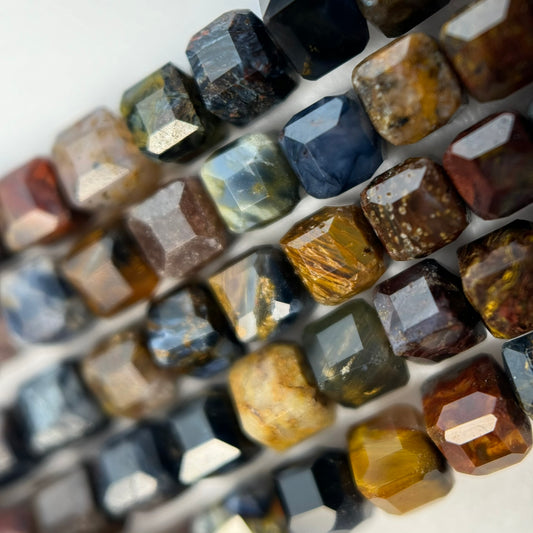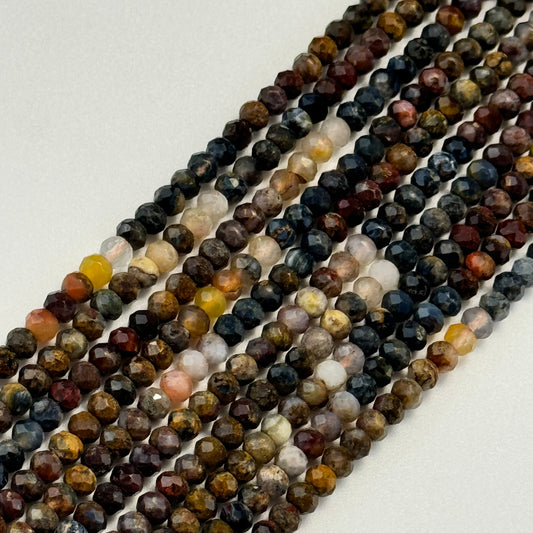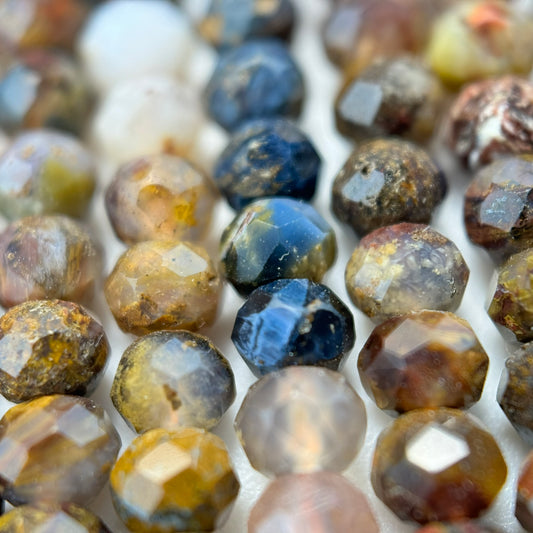Discovering Pietersite Gemstone Beads
Pietersite is a rare and striking gemstone known for its dramatic swirling patterns and chatoyant effects. This unique material combines various minerals to create its distinctive appearance, making it highly sought after by collectors and jewelry designers.
Distinctive Characteristics
- Dramatic swirling patterns
- Chatoyant (cat's eye) effects
- Multi-mineral composition
- Mohs hardness of 6-7
- Rare and collectible
Mineralogical Composition
Pietersite consists of a complex mixture of minerals including crocidolite (blue asbestos), quartz, and various other minerals. This combination creates its unique patterns and optical effects.
Composition Details
- Primary: Crocidolite fibers in quartz
- Quartz matrix
- Various accessory minerals
- Complex intergrowth patterns
- Pseudomorphous structures
Formation and Geological Origins
Pietersite forms through complex geological processes involving the replacement of crocidolite fibers by silica, similar to tiger's eye formation but with unique characteristics.
Formation Process
- Crocidolite fiber replacement
- Silica replacement processes
- Metamorphic conditions
- Extended formation periods
- Specific geological environments
Chatoyancy and Optical Effects
Pietersite's most striking feature is its chatoyancy, creating a silky, moving light effect. The stone also displays dramatic color patterns.
Optical Properties
- Chatoyant effects from fibrous inclusions
- Swirling color patterns
- Light reflection from parallel fibers
- Color variations in patterns
- Dynamic visual effects
Color Variations and Patterns
Pietersite displays various colors including blues, golds, reds, and combinations thereof. The swirling patterns create unique visual effects in each specimen.
Color Characteristics
- Blue tones from crocidolite
- Golden and brown hues
- Reddish colors in some varieties
- Swirling pattern combinations
- Each piece unique
Cutting and Processing Techniques
Proper cutting is essential to maximize Pietersite's chatoyancy and pattern display. The stone must be oriented correctly to showcase its effects.
Cutting Considerations
- Orientation critical for chatoyancy
- Cabochon cuts maximize effects
- Pattern orientation important
- High polish enhances appearance
- Various shapes possible
Hardness and Durability
With a Mohs hardness of 6-7, Pietersite offers good durability for jewelry use, though its fibrous structure requires careful handling.
Durability Factors
- Mohs hardness: 6-7
- Good resistance to scratching
- Fibrous structure requires care
- Stable under normal conditions
- Suitable for jewelry with care
Geographic Sources
Pietersite occurs in limited locations, with notable sources in Namibia and China. Each source may produce material with slightly different characteristics.
Primary Sources
- Namibia: Original discovery location
- China: Commercial material available
- Limited geographic distribution
- Quality varies by source
- Rare occurrence worldwide
Care and Maintenance Guidelines
Pietersite requires standard care to maintain its chatoyant effect and polished appearance. Proper cleaning preserves its beauty.
Care Instructions
- Clean with warm soapy water
- Soft cloth for drying
- Store separately to prevent scratching
- Avoid ultrasonic cleaners
- Protect from harsh chemicals
Jewelry Design Applications
Pietersite beads create striking jewelry pieces with their unique patterns and chatoyant effects. The stone works well in various design styles.
Design Uses
- Statement jewelry pieces
- Showcase chatoyant effects
- Highlight unique patterns
- Combinations with complementary stones
- Contemporary and bold designs
Collectibility and Value
Pietersite's rarity and unique appearance contribute to its collectibility and value. Quality material commands premium prices.
Value Factors
- Rarity increases value
- Pattern quality important
- Chatoyancy intensity affects value
- Color combinations desirable
- Size and cut quality
Metaphysical Properties and Symbolism
Pietersite holds significance in various metaphysical traditions, associated with transformation, protection, and spiritual insight.
Symbolic Meanings
- Transformation and change
- Protection from negative energy
- Spiritual insight
- Emotional healing
- Connection to higher consciousness
Comparison with Related Stones
Pietersite may be confused with tiger's eye or other chatoyant stones. Understanding its specific characteristics aids in identification.
Distinguishing Features
- More dramatic patterns than tiger's eye
- Multiple color combinations
- Complex mineral composition
- Rarer than tiger's eye
- Unique swirling patterns
Frequently Asked Questions
What is the mineralogical composition and classification of Pietersite?
Pietersite is a brecciated (broken and recemented) variety of quartz that contains inclusions of various minerals, most commonly crocidolite (blue asbestos) fibers similar to those found in Tiger's Eye and Hawk's Eye. It's classified as a cryptocrystalline quartz variety with a distinctive brecciated structure that creates its unique appearance.
What causes the brecciated structure and swirling patterns in Pietersite beads?
The brecciated structure in Pietersite results from the fracturing and subsequent recementation of quartz material containing crocidolite inclusions. The broken fragments were naturally recemented with silica, creating angular fragments embedded in a quartz matrix. This process creates the distinctive swirling, chaotic patterns that characterize Pietersite.
What is the Mohs hardness and how does it compare to other quartz varieties?
Pietersite maintains the Mohs hardness of 7, characteristic of all quartz varieties. However, the brecciated structure may create planes of weakness along the fragment boundaries, potentially affecting toughness. The overall durability is good for jewelry, though care should be taken to avoid impacts that could cause fracturing along breccia boundaries.
What causes the blue, gold, and red colorations in Pietersite beads?
The colors in Pietersite come from the crocidolite inclusions and their oxidation states. Blue areas contain unoxidized crocidolite fibers (similar to Hawk's Eye), gold areas contain oxidized crocidolite (similar to Tiger's Eye), and red areas result from further oxidation or the presence of hematite. The brecciated structure mixes these different stages, creating the multicolored appearance.
What are the primary geological sources and formation process of Pietersite?
Pietersite was first discovered in Namibia and is also found in China (Hunan Province). It forms when quartz material containing crocidolite inclusions undergoes fracturing, likely due to tectonic activity or pressure changes, and then becomes recemented with silica. This brecciation and recementation process creates the distinctive appearance.
What is the specific gravity and how does the brecciated structure affect it?
Pietersite has a specific gravity similar to other quartz varieties, ranging from 2.64 to 2.71. The brecciated structure doesn't significantly affect the overall density, as the fragments and matrix are both quartz-based. However, variations in inclusion density across different fragments may cause slight local variations.
How does Pietersite differ from Tiger's Eye and Hawk's Eye?
Pietersite differs from Tiger's Eye and Hawk's Eye in its brecciated structure—it contains broken and recemented fragments rather than continuous, parallel fibers. While Tiger's Eye and Hawk's Eye show smooth, parallel chatoyant bands, Pietersite shows chaotic, swirling patterns with mixed colors and fragment boundaries creating visual complexity.
What optical effects can Pietersite beads exhibit?
Pietersite can exhibit chatoyancy (cat's eye effect) in areas where crocidolite fibers are aligned, though the effect is often interrupted by the brecciated structure. The material may show different optical effects in different fragments—some areas may show the silky chatoyancy of Hawk's Eye, while others show the golden chatoyancy of Tiger's Eye.
What cutting and polishing considerations are important for Pietersite beads?
Cutters must orient Pietersite to maximize the display of brecciated patterns and any chatoyant effects. The material should be cut to showcase the most interesting fragment patterns while avoiding planes of weakness along breccia boundaries. Polishing requires care to maintain the surface integrity and enhance the visual complexity of the brecciated structure.
Can Pietersite beads be enhanced or treated?
Pietersite is typically not treated, as treatments could affect the natural brecciated structure and color variations. The material's unique appearance comes from its natural formation process, and artificial enhancement would diminish its distinctive character. Natural, untreated Pietersite with good color contrast and interesting patterns is most valued.
What causes the variation in pattern complexity among different Pietersite beads?
Pattern complexity varies based on the extent of brecciation, the size of fragments, the degree of recementation, and the distribution of crocidolite inclusions. Some specimens show large, angular fragments creating bold patterns, while others show finer brecciation creating more intricate, swirling designs. The mixing of different oxidation states also affects the visual complexity.
How should Pietersite beads be cleaned and maintained?
Clean Pietersite beads with warm, soapy water and a soft cloth. Avoid harsh chemicals, ultrasonic cleaners, or steam cleaning that could affect the brecciated structure or cause fracturing along fragment boundaries. Store separately from harder materials to prevent scratching, and protect from impacts that could cause cleavage along breccia planes.
What makes Pietersite beads unique compared to other chatoyant quartz varieties?
Pietersite is unique due to its brecciated structure, which creates chaotic, swirling patterns unlike the smooth, parallel bands of Tiger's Eye or Hawk's Eye. The combination of different oxidation states (blue, gold, red) within a single piece, along with the fragment boundaries, creates a distinctive appearance that cannot be replicated in other quartz varieties.
How does the brecciated structure affect the durability of Pietersite beads?
The brecciated structure creates natural planes of weakness along fragment boundaries, which could potentially make the material more prone to fracturing than solid quartz. However, the recementation process helps bind the fragments together. Care should be taken to avoid impacts that could cause separation along these boundaries, though properly cut and polished beads are generally durable.
What are the quality factors that affect the value of Pietersite beads?
High-quality Pietersite beads feature interesting brecciated patterns with good color contrast between blue, gold, and red areas. The fragments should be well-cemented without visible gaps, and any chatoyant effects should be visible and attractive. Specimens with complex, swirling patterns, good color distribution, and strong chatoyancy command higher values.





